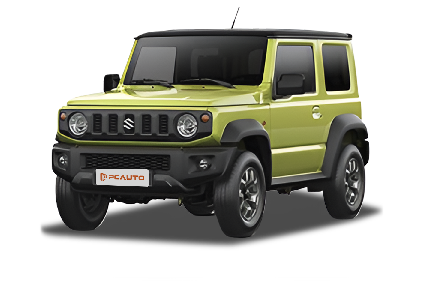Q
suzuki jimny how many seater
The Suzuki Jimny is a total classic when it comes to compact off-roaders. Over in Malaysia, the version you'll find is a four-seater with that 2+2 seating setup – perfect for small families or folks who live for off-road adventures. This little beast has made a name for itself with its killer off-road chops and tough-as-nails body-on-frame construction. Under the hood, there's a 1.5-liter naturally aspirated engine, mated to either a 4-speed auto or 5-speed manual gearbox, delivering that solid, reliable performance you'd expect.
Sure, the cabin's a bit snug, but they've done a smart job with the space. Fold those rear seats down, and the boot opens up nicely – ideal for short road trips or hauling gear for outdoor getaways. For Malaysian drivers, the Jimny's size is a huge plus in the city; it zips through traffic like a breeze. But don't sleep on it out of town either – it handles rough country roads or mountain trails without breaking a sweat.
Now, fair warning: because it's on the smaller side, the back seats might feel cramped on long drives. But for daily commuting or the occasional off-road thrash? It's got all the personality you could ask for. And let's not forget the mod potential – Jimny owners love tweaking theirs. Whether it's upgrading the suspension, slapping on beefier tires, or giving the exterior a custom look, there's no shortage of ways to make it even more capable off-road or turn heads on the street.
Special Disclaimer: This content is published by users and does not represent the views or position of PCauto.
Related Q&A
Q
What engine is in the 2024 Suzuki Jimny?
The 2024 Suzuki Jimny continues to be powered by the well-regarded 1.5-liter K15B naturally aspirated four-cylinder gasoline engine. This powerplant features a lightweight aluminum block, delivering 102 horsepower and 130 Nm of peak torque. It's mated to either a 5-speed manual or 4-speed automatic transmission, and comes standard with a part-time 4WD system with low-range gearing, making it suitable for both city commuting and light off-roading. Known for its durability and low maintenance costs, the engine pairs with the Jimny's classic ladder frame and body-on-frame construction, balancing handling stability and terrain capability. What's notable is that despite its small displacement, the short wheelbase and generous ground clearance make it nimble in tight city streets or rough terrain, while the addition of an electronic limited-slip differential further enhances its ability to get out of tricky spots. For those prioritizing fuel efficiency, keeping an eye on the official maintenance recommendations—like using low-viscosity engine oil or maintaining proper tire pressure—can help optimize real-world fuel economy. While there's no hybrid option yet, this powertrain has been market-tested for years and is particularly well-suited to our region's varied driving conditions.
Q
Is the 2024 Suzuki Jimny a good off-road vehicle?
The 2024 Suzuki Jimny is really a great fit for off-roading. It carries on the Jimny lineup's classic rugged design, with a tough body-on-frame construction, paired with a part-time 4WD system and electronic limited-slip differential, making it a breeze to tackle tricky terrains like mud and sand. Its short wheelbase and good ground clearance also boost its off-road capability. The 1.5-liter naturally aspirated engine might not be the most powerful, but it delivers steady low-end torque, perfect for slow off-road crawling, and it's pretty fuel-efficient too. The interior is simple and functional – the manual handbrake and physical buttons are more direct and reliable when you're out on the trails. To expand a bit, if you're into light to moderate off-roading often, the Jimny's size and agility make it shine on narrow mountain roads or jungle tracks. But if you need to do a lot of highway driving or haul cargo, the space and comfort can feel a bit lacking. Maintenance costs are relatively affordable too, with plenty of parts available, which is good for folks who love outdoor adventures but don't want to spend a fortune. All in all, the 2024 Jimny keeps its traditional strengths in off-road performance and stands as a solid value in entry-level off-roaders.
Q
What engine is in the Jimny 2024?
The 2024 Jimny still packs a 1.5-liter K15B naturally aspirated four-cylinder gasoline engine, cranking out 102 horsepower and 130 Nm of peak torque. It's mated to either a 5-speed manual or 4-speed automatic gearbox. This powertrain is known for its durability and low maintenance costs, making it a solid fit for city commutes and light off-roading. While the power figures aren't exactly head-turning, the Jimny shines off-road thanks to its lightweight body and ladder frame construction. The part-time 4WD system with low-range gearing to multiply torque handles mud, gravel, and other tricky terrains with ease. One thing to note: this engine uses multi-point fuel injection instead of direct injection. Yeah, it's a bit behind the curve on fuel efficiency compared to the latest tech, but it's way more forgiving with lower-quality fuel, which is a big plus in areas where gas station infrastructure is hit-or-miss. If you're craving more power, the turbocharged versions available in some overseas markets might pique your interest, but don't hold your breath for them here anytime soon—emission regulations are probably going to keep them out. For daily use, I'd recommend keeping an eye on your spark plugs and throttle body. With these small-displacement naturally aspirated engines, keeping the intake system clean is key for maintenance.
Q
How much is the Jimny 2024?
The latest prices for the 2024 Jimny range from approximately 150,000 to 180,000 Ringgit, depending on the trim level and configuration. Exact pricing may vary due to dealer promotions or optional accessories. This model retains the iconic boxy design and robust off-road capabilities, powered by a 1.5L naturally aspirated engine paired with a 4AT transmission, and features the ALLGRIP PRO part-time 4WD system—perfect for outdoor adventure enthusiasts. Notably, the 2024 version has been refined for better sound insulation and suspension comfort while keeping hardcore elements like the ladder frame chassis and three-link rigid axle suspension. As a compact off-roader, it offers great modification potential; local owners often add off-road tires or roof racks. Before purchasing, it’s advisable to test drive at an authorized showroom to experience its unique driving feel and inquire about after-sales warranty policies, which typically cover 5 years or 100,000 kilometers. Fuel economy is moderate, averaging around 12-14L/100km in urban driving, but increases significantly in off-road conditions.
Q
Is Jimny good for city driving?
As a compact SUV, the Suzuki Jimny holds its own pretty well for city driving in Malaysia. That 3.7-meter short body is a total lifesaver for squeezing through tight lanes and nailing those tricky parking spots in congested cities like KL. The 1.5L naturally aspirated engine paired with the 4AT gearbox isn't going to win any drag races, but it's got enough low-end torque to handle stop-and-go city traffic without breaking a sweat – though you will notice it drinks a tiny bit more fuel than your average urban SUV.
Let's talk ride quality: the Jimny's body-on-frame construction and solid axle suspension can feel a bit jiggly on smooth tarmac, but that generous ground clearance? It laughs at Malaysia's potholed roads and those annoying temporary roadblocks you find everywhere. A heads-up though – the back seat is pretty snug. It's perfect for 1-2 people commuting daily, but if you're regularly ferrying around a full crew, comfort might take a hit.
Here's where the Jimny really shines, though – off-road capability, which is a huge plus for adventure-loving owners. Weekends up to places like Cameron Highlands or Fraser's Hill? This little rig handles those mountain roads like a champ. Over in the Malaysian market, Jimnys hold their value surprisingly well, and servicing is generally straightforward – just be prepared that original parts can be a touch pricier than your run-of-the-mill city cars.
Q
Does Jimny have resale value?
In the Malaysian market, the Suzuki Jimny actually maintains a relatively high resale value as a used car, which is primarily attributed to its unique design, solid off - road capabilities, and relatively limited supply. As a compact, hardcore off - roader, it has no direct local competitors. Plus, with that classic boxy shape and impressive go - anywhere ability, it has a large fan base among off - road enthusiasts and buyers looking for something with personality—so demand for used ones stays steady. The high prices of new cars and long waiting periods also indirectly support the resale values of second - hand vehicles.
Based on actual market data, a 3 - year - old Jimny typically retains about 65% to 75% of its original price, which outperforms city SUVs in the same price bracket. It's worth noting, however, that the actual resale value is influenced by the vehicle's condition, mileage, and any modifications made. Unmodified models with complete factory service records are undoubtedly more in demand in the used car market.
When Malaysian consumers purchase a niche vehicle like this, in addition to considering the resale value, they should also take into account their actual usage scenarios. The on - road comfort and interior space of the Jimny cannot compare with those of mainstream SUVs, however, its off - road capability is second to none among niche vehicles. This unique positioning is precisely what enables it to maintain its value so effectively.
Q
Where is Jimny built?
The Suzuki Jimny is currently rolling off the production lines at Suzuki's Hamamatsu plant in Japan, and this classic compact off-roader has built a global fanbase – Malaysia included – thanks to its tough-as-nails body-on-frame construction and impressive go-anywhere capabilities. Underpinning that rugged character is a ladder frame chassis paired with a part-time 4WD system, making it a solid fit for Malaysia's diverse landscapes. Whether you're navigating city streets or tackling weekend adventures, the Jimny handles it all with ease.
What really stands out, though, is how this little SUV punches above its weight when the going gets rough. Its generous ground clearance and short wheelbase translate to exceptional off-road articulation, which is a big reason it's a hit for tackling Malaysia's rainforests and rural tracks. For Malaysian buyers, the Jimny's appeal goes beyond just off-road prowess. Its relatively affordable price tag and low running costs are major draws, and when you factor in Suzuki's well-established after-sales network locally, it becomes the perfect pick for folks who want genuine off-road fun without breaking the bank. And in recent years, as Malaysian buyers have shown a growing appetite for more individualistic rides, the Jimny's retro-cool looks and massive potential for customization have only added to its popularity, especially among younger drivers.
Q
Are Jimny Motors reliable?
The Suzuki Jimny has built a solid fan base among Malaysian drivers, thanks to its tough, no-nonsense design and impressive off-road capabilities – it’s especially well-suited for the country’s varied terrain. This little SUV packs a 1.5L naturally aspirated engine that delivers smooth power while keeping fuel costs in check, and with relatively low maintenance expenses, it’s a smart pick for budget-conscious buyers. When it comes to reliability, the Jimny has a proven track record; its chassis and mechanicals have stood the test of time with minimal issues. That said, its lightweight body does mean some wind noise at highway speeds, and the interior leans more toward practicality than luxury – though for folks who prioritize function over frills, that’s hardly a dealbreaker. The Jimny also holds its value well in Malaysia’s used car market, which speaks volumes about its dependability. If you’re frequently tackling rural roads or light off-roading, the Jimny is definitely worth a look – just remember to keep up with regular servicing to keep it running strong for years to come.
Q
Why is Jimny famous?
The Jimny is renowned for its unique rugged off - road design, reliable performance, and compact, nimble body – traits that make it stand out in Malaysia's varied terrain. As a Suzuki classic, it features a body - on - frame construction, a part - time four - wheel - drive system, and ample ground clearance, enabling it to handle mud, gravel, and even light climbing trails with ease. No wonder it's a hit among off - road enthusiasts and outdoor adventurers.
Then there's its compact size, which is perfect for Malaysia's tight city streets and rural backroads. Coupled with decent fuel efficiency, it achieves a good balance between daily commuting and weekend adventures. In recent years, the Jimny's retro boxy looks have also attracted the attention of fashion - conscious individuals, making it a popular choice for customization and modifications.
Furthermore, its strong resale value in the used car market – a testament to its solid reputation and durability. For Malaysian buyers, the Jimny isn't just a practical off - roader; it's a lifestyle symbol, ideal for drivers who crave freedom and adventure.
Q
Why was Jimny discontinued?
So, why did the Jimny get the axe in Malaysia? Let's break it down. The main culprit is the ever-tightening global emissions regulations, especially the Euro 6 standards. The third-gen Jimny (JB74) with its 1.5L engine just couldn't keep up with the latest green demands, and Suzuki hasn't rolled out a compliant upgrade specifically for Southeast Asia yet.
On top of that, the Malaysian government's recent tweaks to import duties and certification processes have jacked up the cost of bringing in small off-roaders, chipping away at the Jimny's competitiveness. Don't get me wrong, the Jimny's a total legend among off-road enthusiasts – that short wheelbase and body-on-frame setup are pure off-road DNA. But let's be real, those same traits make it a bit of a handful for daily city driving and not the most fuel-sipper out there.
Now, the fourth-gen Jimny is out in some markets with the necessary updates to meet new rules. But here's the thing: Malaysians are pretty price-sensitive, and the SUV segment is fiercely competitive. So Suzuki's probably hitting pause on bringing it in for now.
If you're a Malaysian off-road fan craving something small but capable, don't despair. Keep an eye on alternatives like the new Toyota Land Cruiser or Mitsubishi Pajero Sport. They've both got the off-road chops and are fully compliant with local regulations.
Popular Cars
Model Year
Car Compare
Car Photo
Latest Q&A
Q
How much did a new 2018 beetle cost?
The 2018 Volkswagen Beetle had a starting price range of approximately RM120,000 to RM180,000, depending on the trim and options. The entry-level 1.2 TSI Design model was the most affordable, while the top-spec 2.0 TSI R-Line version approached RM180,000—though final pricing could vary with optional extras and dealer promotions.
As a timeless classic, the 2018 Beetle kept its retro charm but packed modern tech like a touchscreen infotainment system and active safety features. Under the hood, buyers could choose between the fuel-efficient 1.2T or the more spirited 2.0T engine.
Fair warning: Volkswagen discontinued the Beetle in 2019, so you’ll only find it on the used market now. That said, its iconic design and nostalgic appeal still make it a hit among collectors. If you’re eyeing a pre-owned model, always check the vehicle history and maintenance records to snag a solid deal.
Q
What engine does a 2018 VW Beetle have?
The 2018 Volkswagen Beetle offered two gasoline engine options across different markets. The primary powerplant was a 1.2-liter TSI turbocharged inline-four, delivering 105 horsepower and 175 Nm of torque, paired with a 7-speed DSG dual-clutch transmission. This compact forced-induction engine struck a balance between urban fuel efficiency and strong low-end torque.
Higher-spec variants featured an optional 1.4-liter TSI turbocharged unit, bumping output to 150 horsepower. Both engines adopted direct fuel injection and belonged to VW’s widely used EA211 modular family, featuring modern tech like lightweight aluminum blocks.
Though retaining its iconic silhouette, this generation Beetle actually shared its underpinnings with the Golf, inheriting the brand’s proven front-wheel-drive architecture. This platform commonality also translated to easier maintenance, as local dealerships were well-versed in servicing these powertrains thanks to extensive parts sharing across VW’s lineup.
Q
What are the different models of the 2018 VW Beetle?
The 2018 Volkswagen Beetle comes in three main trims: Classic, Trendline, and Sport. All models are powered by a 1.2-liter TSI turbocharged engine delivering 105 horsepower, paired with a 7-speed DSG dual-clutch transmission—perfect for city driving with its nimble handling and solid fuel efficiency.
The entry-level Classic trim rolls on 16-inch wheels and features a basic multimedia system. Stepping up to the Trendline adds 17-inch wheels, fog lights, and chrome accents. The Sport trim leans into its name with 18-inch wheels, a sport-tuned suspension, and unique interior color options.
This generation keeps the Beetle’s iconic retro curves but modernizes them with touches like LED daytime running lights. Inside, you’ll find color-matched dash panels, and with 310 liters of trunk space, it’s more practical than most small cars in its class.
Since the Beetline was discontinued in 2019, the 2018 model stands as the last new generation, making it a rising collector’s item—especially the convertible, which holds strong appeal in the used market. For maintenance, stick to routine service every 15,000 km or 12 months, and regular 95-octane fuel is all it needs.
Q
Does the 2018 Beetle have Apple CarPlay?
The 2018 Volkswagen Beetle did come equipped with Apple CarPlay, integrated into its Composition Media infotainment system. This allowed iPhone users to seamlessly connect for navigation, music, and other apps. The system also supported Android Auto, catering to different smartphone users with its intuitive and responsive interface—definitely a plus for convenience on the road.
That said, some early-production 2018 models might require a software update to activate the feature, so it’s worth checking with an official dealer to confirm your car’s specs or available upgrades. Also, wireless Apple CarPlay wasn’t standard across all trims; it depended on the factory-installed options.
For fans of classic styling who still want modern tech, the Beetle struck a nice balance between retro charm and everyday usability. Competitors like the Mini Cooper offered similar connectivity, but let’s be honest—the Beetle’s iconic design was always its standout feature.
Q
What is the fuel economy of the 2018 Beetle?
The 2018 Volkswagen Beetle's fuel efficiency varies by powertrain. The 1.2L TSI turbocharged version delivers a combined fuel consumption of around 5.5L/100km, while the 1.4L TSI model is slightly thirstier at approximately 6.0L/100km – both perform best with 95-octane petrol.
You'll likely see higher consumption in city driving, but it cruises efficiently on highways thanks to its classic aerodynamic design. For better mileage, stick to routine maintenance like cleaning the air filter and keeping tyres properly inflated. These small habits can help squeeze out extra kilometres per litre.
Though discontinued, the 2018 Beetle remains popular in the used car market – its iconic styling and decent fuel economy make it a practical daily driver. Just remember real-world figures depend heavily on driving style and road conditions, so check owner forums for real-life feedback.
View MoreRelated News

How to improve the power of Suzuki Jimny?
AshleyNov 27, 2025

Only 55! Limited-Edition Jimny Coming to France
MichaelJun 20, 2025

Suzuki Jimny's Trusted 4WD System: Unleash Off-Road Thrills
Kevin WongMay 13, 2025

Jimny Nomade Japan released, over 50,000 orders in 4 days, consumers need to wait for 3.5 years
MichaelFeb 5, 2025

Suzuki Jimny Arctic Launch: Limited Time Offer to Save 7000 Ringgit!
Kevin WongNov 18, 2024
View More


















Pros
Cons